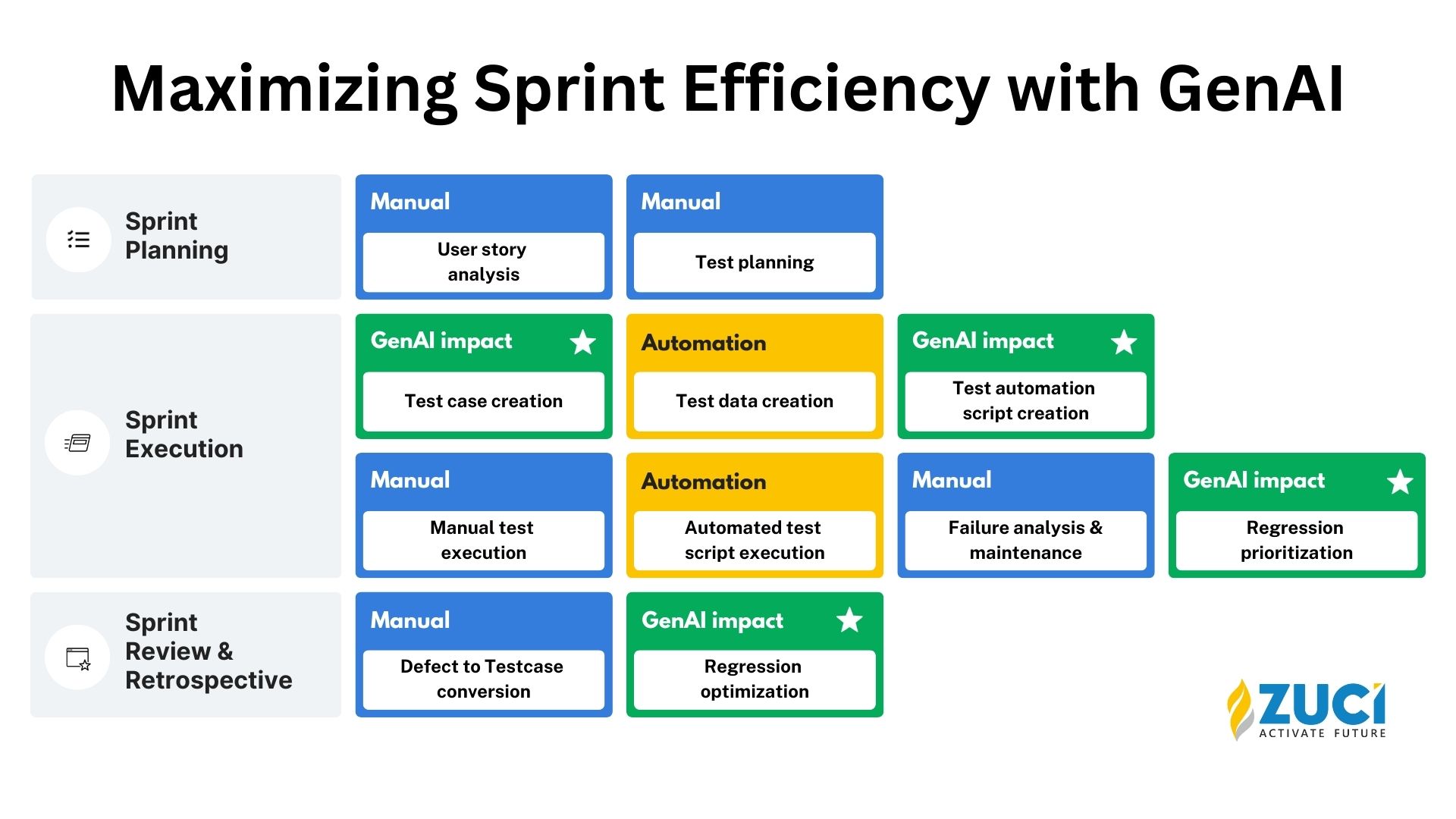Maximizing Sprint Efficiency with GenAI
An INFJ personality wielding brevity in speech and writing.
The Reality of Modern Sprints
Every engineering team knows the challenge: delivering quality at speed while managing growing complexity. Sprints often feel like a constant balance between thoroughness and timeliness.
Modern sprint cycles face three critical bottlenecks:
- 40-50% of sprint time spent on test creation and execution
- Regression suite maintenance consuming 25-30% of QA bandwidth
- Manual test case creation leading to time consumption in addition to inadequate test coverage
The introduction of Generative AI into this ecosystem isn’t just another tool addition – it’s changing how we think about quality assurance within sprint cycles.
Understanding the GenAI Impact
Looking at the current sprint methodology, we can see three distinct areas where GenAI is making a meaningful difference:

Sprint Planning
The traditional approach to sprint planning has always been experience-driven. Seasoned QAs know where to look for issues, what edge cases matter, and how to structure test coverage.
Current Manual Processes:
- User story analysis
- Test planning
GenAI complements this expertise by:
- Analysing user stories to suggest test scenarios that might be overlooked
- Identifying potential integration points that need coverage
- Suggesting data variations that could expose edge cases
Expected outcome: 60% reduction in test planning time
You might be interested in knowing how GenAI transforms the software quality pyramid here.
Sprint Execution
This is where the most tangible benefits emerge. The framework shows several key touchpoints:
Test Case Creation and Automation: Rather than replacing existing automation frameworks, GenAI acts as an accelerator. It can:
- Transform manually written test cases into automation scripts
- Suggest optimal approaches for handling dynamic elements
- Generate data-driven test variations
- Execute parallel test automation
Measurable benefit: 70% reduction in script creation time & 3x faster test execution cycles
Test Data Management: One of the most time-consuming aspects of testing has always been data preparation.
GenAI helps by:
- Generating synthetic test data that matches production patterns
- Creating edge case scenarios
- Maintaining referential integrity in complex data sets
Impact: 80% reduction in test data preparation time
Regression Testing
Perhaps the most interesting application is in regression optimization. GenAI can analyze code changes and suggest which test cases are most relevant, helping teams:
- Focus on high-risk areas
- Reduce redundant test execution
- Identify gaps in existing coverage
- Outcome: 40% reduction in regression testing time
Our clients have vouched that Zuci’s ZenRelease helped them solve their regression testing challenges and saving significant amounts of time and manual effort.
Sprint Review & Retrospective
The framework shows how GenAI can help teams learn from each sprint:
- Converting discovered defects into preventive test cases
- Identifying patterns in issues that emerge
- Suggesting optimization opportunities in test suites
Impact: 30% smaller, more efficient test suites & 50% reduction in defect recurrence
Real Insights from the Field
Teams implementing GenAI in their sprint cycles have shared some interesting observations:
- Quality of Suggestions “The AI doesn’t just generate more test cases – it generates relevant ones. It’s learning from our domain context and previous issues.”
- Time Reallocation Instead of reducing QA headcount, teams are finding their testers can focus on more complex scenarios and exploratory testing.
- Learning Curve “The initial setup requires patience. The AI needs time to understand your application’s patterns and testing approach.”
Challenges Worth Noting
AI Integration Complexity
- Existing CI/CD pipelines need significant modifications
- Version control systems may not handle AI-generated code well
- Test management tools lacking proper APIs for AI integration
- Difficulty in maintaining traceability between AI-generated and manual tests
Infrastructure Requirements
- High computational resources needed for model training
- Latency issues when generating test cases in real-time
- Cost of GPU/CPU resources for continuous AI operations
- Network bandwidth constraints with large model interactions
Team Resistance
- Fear of job displacement causing passive resistance
- Resistance to changing established testing practices
Skill Gap
- Prompt engineering expertise
- AI model fine-tuning knowledge
- Understanding of AI limitations
- Hybrid testing approaches
Process Adaptation
- Traditional sprint ceremonies needing restructuring
- New review processes for AI-generated artifacts
- Modified definition of done including AI validation
- Updated test review guidelines
Real-World Example
Company: E-commerce Startup
Challenge: Resource constraints
Issues Faced:
- Limited GPU access
- Team expertise gaps
- Cost overruns
How Zuci helped: Phased implementation with cloud resources
Learning: Start smaller, scale gradually
Looking Forward
The future of sprint efficiency isn’t about replacing human judgment but enhancing it. The most successful teams are those who:
- Use GenAI as a collaboration tool rather than a replacement
- Maintain a balance between automated suggestions and manual oversight
- Focus on continuous learning and adaptation
The Pragmatic Approach
For teams interested in exploring GenAI for sprint efficiency:
- Start with a single aspect of testing where you face clear challenges
- Focus on learning from the results rather than immediate efficiency gains
- Allow time for both the team and the AI to adapt and improve
Remember: The goal isn’t to transform your entire testing process overnight, but to gradually enhance your existing practices with AI capabilities where they make sense.
The integration of GenAI into sprint cycles represents a significant shift in how we approach software quality. While it’s not a magic solution, when applied thoughtfully, it can help teams achieve better coverage, faster feedback, and more efficient use of human expertise. The key is to approach it as an evolution rather than a revolution – building on your existing strengths while gradually incorporating AI capabilities where they add genuine value.
Related Posts























